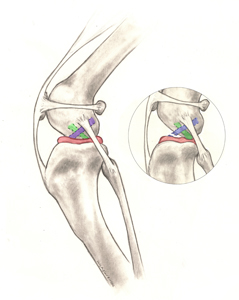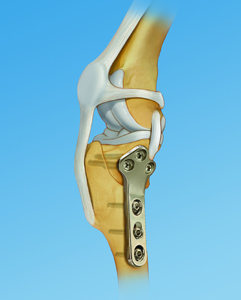TPLO
Tibial plateau leveling osteotomy (TPLO) is a procedure that stabilizes a dog’s knee that has a cranial cruciate ligament rupture.
Tibial Plateau Leveling Osteotomy (TPLO)

What is a cranial cruciate ligament rupture?
The cranial cruciate ligament (CCL) is one of the stabilizers of the knee. The CCL is the same as the anterior cruciate ligament (ACL) in humans. The CCL originates on the caudal aspect of the femur and inserts on the cranial aspect of the tibia. In the picture below, the CCL is purple.
What happens when the CCL is ruptured
In a dog, the tibial plateau is sloped to the back of the knee. The job of the CCL is to keep the femur (thighbone) centered over the tibia (shin bone). The CCL can rupture completely or partially. If the CCL is partially ruptured, your dog will show lameness with activity but still use the affected leg. When the CCL is torn completely, the tibia will slide forward in relation to the femur, causing the knee to be unstable. With a complete CCL rupture, your dog will often not use the leg when walking and touch their toes down when standing.

What are the signs of a CCL injury?
- Difficulty rising from a seated position
- Lameness (limping) of variable severity
- Muscle atrophy (decreased muscle mass in the affected leg)
- Unwillingness to play and decreased activity level
What is a TPLO?
TPLO stands for tibial plateau leveling osteotomy and is used in dogs with a CCL rupture. The tibial plateau is the top of the tibia. A cut (osteotomy) is performed in the proximal portion of the tibia to isolate the tibial plateau. The plateau is rotated (leveled off), and a plate is placed to hold the bone in the new position. The TPLO changes the biomechanics of the knee, so the dog does not need the CCL anymore.

How long is post operative recovery?
The bone typically heals in 8 weeks. Most dogs need 12 weeks of confinement to allow the soft tissues and the bone to heal. Controlled postoperative activity allows for two objectives to be met – one is the soft tissues have time to reinforce themselves and to get used to their new tissue loads. The second objective is for the bone to heal. Once recovered, 90 to 95% of patients return to an active lifestyle.
